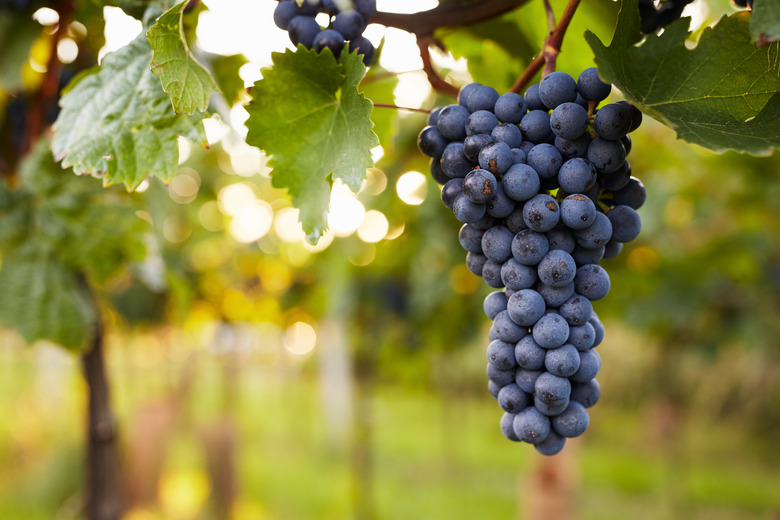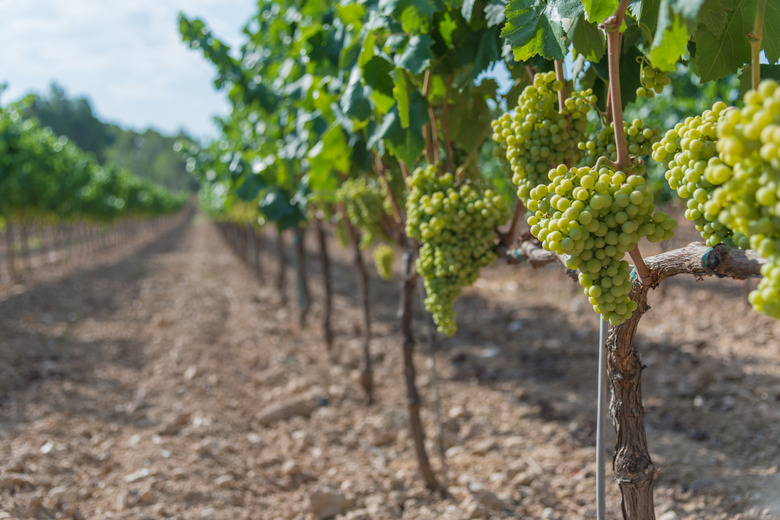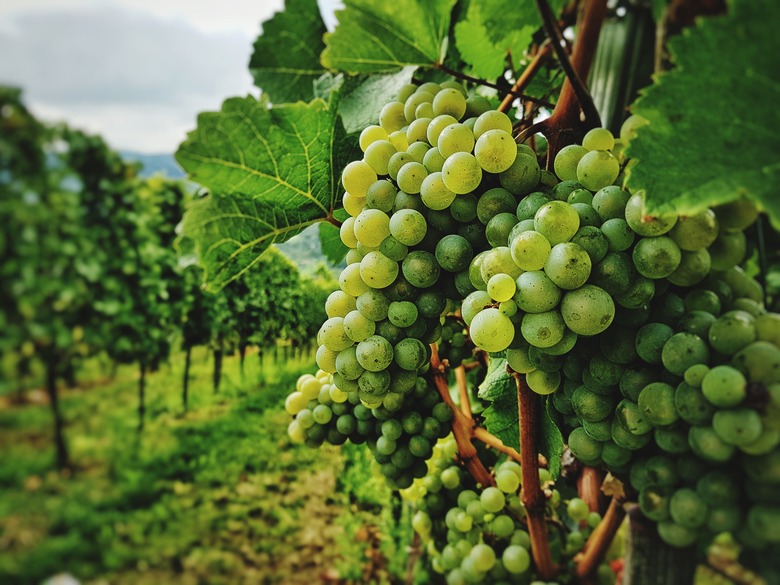How To Grow Grapes
Grapes (Vitis spp.) are woody perennial vines that produce flowers and subsequent fruit in clusters. Though the greenery of the foliage does have ornamental appeal, grapes are normally grown for the edible fruit. There are more than 40 highly edible species of grapes, but the cultivars most often grown in home gardens are derived from different species, such as:
- Vitis labrusca (usually known as fox grapes), which have good cold hardiness. Zones 5-8
- Vitis vinifera (European grapes), normally grown for wine. Zones 6-10
- Vitis rotundifolia (native grapes, aka muscadines and scuppernongs). Zones 5-9
- Hybrids, which are normally European grapes grafted onto North American root stocks.
In the wild, grapevines sometimes grow to 40 feet or more, but when grown in the garden for edible fruit, they are usually kept closely pruned to 10 feet or less. Most grape varieties bloom in thick panicles of flowers in May or June with the flowers giving way to fruits (grapes) that ripen in summer.
Grapes are somewhat easier to maintain than tree fruits, but they do require careful pruning if you want to maximize fruit production. Like many fruit species, they are subject to a variety of pest and disease issues. In the right environment, a grape plant can last up to 30 years or more, providing dependable fruit after just a year or two.
Best Uses for Grapes
Best Uses for Grapes
Grapes are generally grown by gardeners who want to grow table grapes, who wish to crush them into pulp to make wine, jams/jellies or who want to dry them for raisins. Grapes can also serve as an ornamental plant for covering fences, walls and arbors. The twisting and dense foliage adds landscape interest, and some varieties have attractive fall foliage color.
How to Grow Grapes
How to Grow Grapes
-
Common Name: Grapes
-
Botanical Name: Vitis spp.
-
When to Plant: Spring
-
USDA Zones: 4 to 10, depending on cultivar (zones 5 to 9 have the most options)
-
Sun Exposure: Full sun
-
Soil Type: Rich, well-draining soil
-
When it's in Trouble: Yellowish color in the leaves; visible insect or disease damage
-
When it's Thriving: Deep-green leaves, plentiful flowers in spring followed by fruit
Starting Grapes From Plants
Grapes are normally planted in spring from either container-grown plants purchased from nurseries or from bare-root stock purchased from mail-order or online retailers. Grapes are best grown in rows on a trellis or on sturdy stakes. Spacing for the plants varies according to the type of grape. Most table and wine grapes should be spaced 6 to 8 feet apart, but the muscadine grapes frequently grown in the deep South should be planted 12 to 15 feet apart.
A good system for growing many grape plants is known as the Kniffin system. It involves driving 7- to 8-foot stakes at 10-foot intervals in rows. Run two strands of heavy wire 3 and 5 feet above the ground, attaching it to every post. You may want to stake the end posts diagonally to the ground for extra strength.
After planting, prune each grape plant down to one cane and then cut that single cane down in length so that just three buds remain. Attach the cane to the bottom wire with plant ties. As the plant begins to grow, keep the best shoots and trim away the others. As these canes grow, wire them together to form a trunk for the grapevine.
When the central trunk reaches about 6 feet in height, attach it to the top wire. Cut away all the side shoots except for four to six shoots near each wire — two or three "arms" pointing in each direction. As these side canes grow toward one another in the next year, cut away all but the sturdiest canes. The goal is for each plant to have four horizontal arms — one running in each direction on each of the two wires.
In What Zone Do Grapes Grow Best?
In What Zone Do Grapes Grow Best?
There are grape varieties appropriate for most USDA plant hardiness zones (2 to 10), but this plant is best grown in zones 5 to 9, specifically in areas that enjoy hot, dry days and cooler nights. This is the reason the sunny mountain slopes of places like California, the Mediterranean and southern France are the classic grape-growing regions.
Nearly every U.S. region can find some grape cultivars developed for its climate, but you will have more trouble growing grapes in a climate that is consistently humid. The best way to find grapes that are suitable for your locale is to consult your local county extension service or a good local nursery. Online retailers have good tools for finding the grape varieties that are well-suited to each region.
When Should You Plant Grapes?
When Should You Plant Grapes?
Spring is the best time to plant grapevines, as it gives the plants plenty of time to establish good root systems before the coming winter. This is especially true of bare-root grapes purchased from online retailers. With nursery plants growing in pots, you can plant at almost any time, though professionals still recommend spring as the ideal time.
Grapes that have been grown in containers in a greenhouse environment should be carefully acclimated to outdoor conditions before you plant them in the garden. Harden them off over a week or so by providing increasingly long visits to the outdoors and bringing them in at night. After acclimating this way, the plant should be ready to transplant into the garden.
Soil, Sunlight and Water Recommendations for Grapes
Soil, Sunlight and Water Recommendations for Grapes
Grapes do best when planted on rich, very well-draining soil that has a pH level of 5.5 to 6.5 (slightly acid). South-facing hillsides are an ideal location for grapes. They will not perform well on dense, clay soils or in boggy, wet soils. In high-clay soil, amend the entire planting site with dehydrated cow manure, garden compost, cocoa fiber or peat moss before planting. Grapes should be planted in a full-sun location if possible, though some varieties will do fine with as little as six hours of sun daily.
Carefully plant potted grapes at the same depth they were growing in their nursery containers. Grapes generally need about 1 inch of water per week through rainfall, irrigation or a combination of both.
Grapes are fairly heavy feeders and should be fertilized once early in the spring and then again after six and 12 weeks of growth. About 2 ounces of ammonium nitrates spread on the ground around the base of the plant is a traditional fertilizer for grapes, but it's best to fertilize at the recommendation of a soil test to eliminate the guesswork.
How to Winterize Grapes
How to Winterize Grapes
The winterizing routine for grapes starts with careful cleanup of ground debris. This is essential to remove shelter that can harbor disease pathogens and insect nesting areas over the winter.
The most important task occurs in late winter or early spring just before the plant is ready to send new growth. At this time, you need to prune the grapevines to ensure good fruit production in the coming season. From the third year of growth onward, your grapevine needs to be severely pruned each year, removing up to 90 percent of the previous year's growth.
Pruning grapes can seem complicated, and the exact method used can vary depending on whether you are formally training the grapevine on wires using the Kniffin method or simply allowing it to climb informally on a fence, wall or trellis. Whatever method you use, the important thing is to remember is that grapes produce fruit from new shoots that grow off last year's new growth. So, the goal with any pruning method is to retain some selected 1-year-old shoots as the foundation for the new shoots that will produce the coming season's grapes. This 1-year wood tends to have a reddish-brown color and will be roughly the diameter of a pencil or slightly larger.
Begin by inspecting the grapevine and removing any old canes that are very thick or are clearly damaged or diseased. Remove these canes as close as possible to the main trunk using very sharp pruning shears. Also remove any suckers growing up from the ground at the trunk of the vine. If you have trained your grapevine on wires, remove all canes that don't fit the desired shape of one strong vertical trunk and the horizontal "arms" extending from the trunk onto the cordons of the trellising system.
Now, identify the 1-year-old stems, which will usually be reddish-brown in color and roughly the thickness of a pencil or your finger. Next, shorten these chosen 1-year-old shoots so that only about eight to 10 buds remain on each of them. The new growth that grows from these buds is where the flowers and grapes will be produced in the upcoming growing season.
Repeating this drastic late-winter pruning routine each year will keep your vines bearing well for many years.
How to Harvest Grapes
How to Harvest Grapes
Grapes are normally ripe when they are in the process of changing color and when the fruit becomes slightly soft to the touch. If you see birds beginning to feed on your grapes, this is also a good sign that they are ready for picking.
Harvest the grapes on a day that is dry rather than wet, as wet grapes don't keep as well as dry grapes. Extend the bunch out from the vine and snip it away using sharp shears. Most grape plants will produce about 10 to 15 pounds of grapes each year. An exception is the muscadine vine, which may produce up to 35 pounds of grapes each year. Remove any damaged or overly soft grapes and then store the bunches in sealed plastic bags or containers in the refrigerator.
Common Pests and Other Problems for Grapes
Common Pests and Other Problems for Grapes
Grapes are as delicious to animals and insects as they are to humans. Some of the most common intruders include these animals and insects:
- Raccoons can devour an entire crop in an evening or two and may tear the grapevine to ribbons as they do so. Raccoons are effectively deterred only by electric fencing. A pugnacious dog turned loose in the garden may also keep them away.
- Birds love to feed on grapes. Draping the vines with bird netting usually keeps birds away.
- Grape berry moths are some of the most damaging of all insects that affect grapes. Small, brown moths lay eggs that hatch into larvae, which feed heavily on stems, leaves and fruit. Be religious about fall cleanup. Severe infestations call for chemical pesticides or orchard sprays.
- Grape leafhoppers are pale-yellow insects with brown or yellow spots. Adults and nymphs cause yellow stippling on the leaves. It takes a large infestation to really harm the vines, but if you need to control them, try an insecticidal soap or orchard spray.
- Scale are tiny insects that cause crusty raised bumps on the stems of grapes. Serious infestations can weaken and kill the canes. Treat scale with insecticidal soap, horticultural oil or a chemical insect killer that's safe to use on edible crops. Mild infestations are not a cause for worry.
- Leafrollers are blackish-gray insects with snout-like mouth parts. The larvae web the leaves together and then feed from inside the joined leaves. Initial infestations can be mild, but these insects go through three cycles a season, and by the end of the year, they can strip a grapevine bare. Control them with Bacillus thuringiensis (Bt) or a chemical insecticidal spray.
- Grape flea beetles are tiny, blue-purple or blue-green insects that feed on the vine's primary buds. Remove debris to eliminate overwintering shelter. Chemical fruit spray is the only solution for severe infestations.
- Japanese beetles are beautiful, shimmery, green beetles that feed heavily on the leaves of many plants, usually in July. Readily visible on grapes, Japanese beetles can quickly reduce leaves to skeletal remains. Remove the beetles by hand or use a chemical fruit-tree spray. Treating lawn grubs, which are the larvae of the beetles, may reduce the beetle infestation.
Common Diseases for Grapes
Common Diseases for Grapes
A large number of diseases can affect grapes, especially fungal diseases. If you have trouble identifying a disease precisely, there is a good chance it is a fungal disease of some type. Good garden cleanup will keep fungal spores from overwintering. A variety of orchard sprays and fungicides designed for edibles can be used to combat these diseases:
- Anthracnose, sometimes called bird's-eye rot, is a fungal disease that causes black or brown lesions to form on young leaves. The grapes may also develop these lesions. The best control is to treat with a fungicide spray or dust.
- Botrytis bunch rot is a fungal disease that causes early-season deformities to the growth shoots and flowers, often immediately after a rain. Remove some of the affected leaves around the infected area to keep it from spreading. A fruit tree spray may also successfully treat this disease.
- Pierce's disease is a bacterial ailment that is spread by sharpshooters, leafhoppers, and spittlebugs. It causes chlorotic yellowing spots that gradually spread and cause the entire leaf to wither and die. Controlling the insects that carry the disease can help, and you can also buy disease-resistant grape cultivars.
- Black rot is a fungal disease that causes reddish-brown spots on leaves and turns the fruit into hardened "mummies." Carefully clean up the dead fruit and leaves before winter to prevent the fungal spores from overwintering. Fungicidal dust or orchard spray can also kill the fungus.
- Downy and powdery mildew cause powdery or webby white coatings on leaves and fruit. Mild cases of downy and powdery mildew are not all that serious, but if the infestation is widespread, use an orchard spray to control these fungal diseases.


